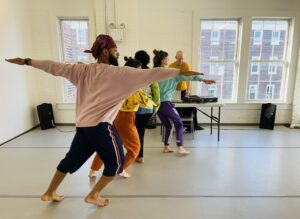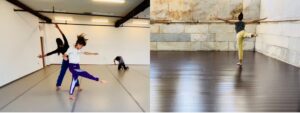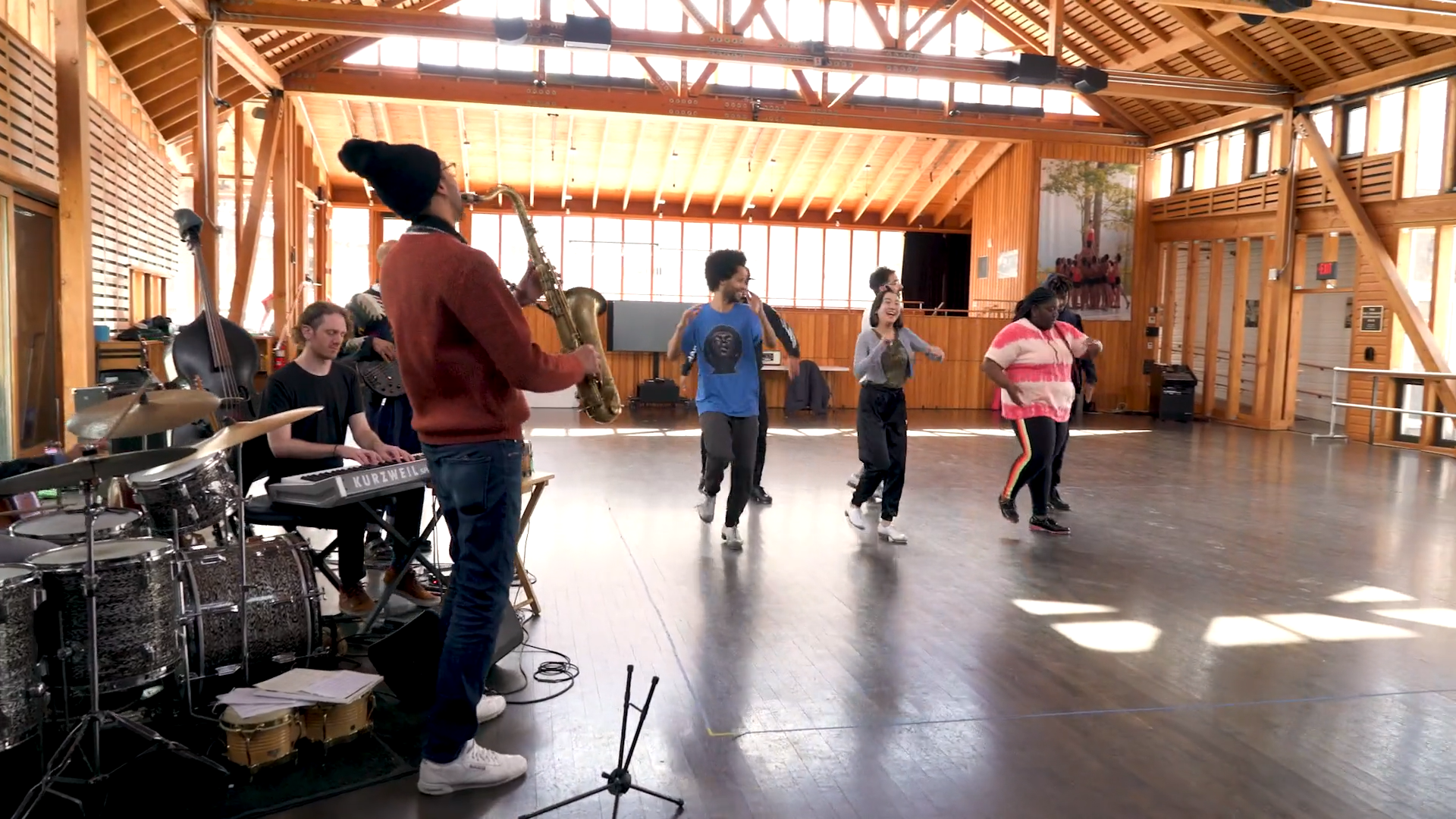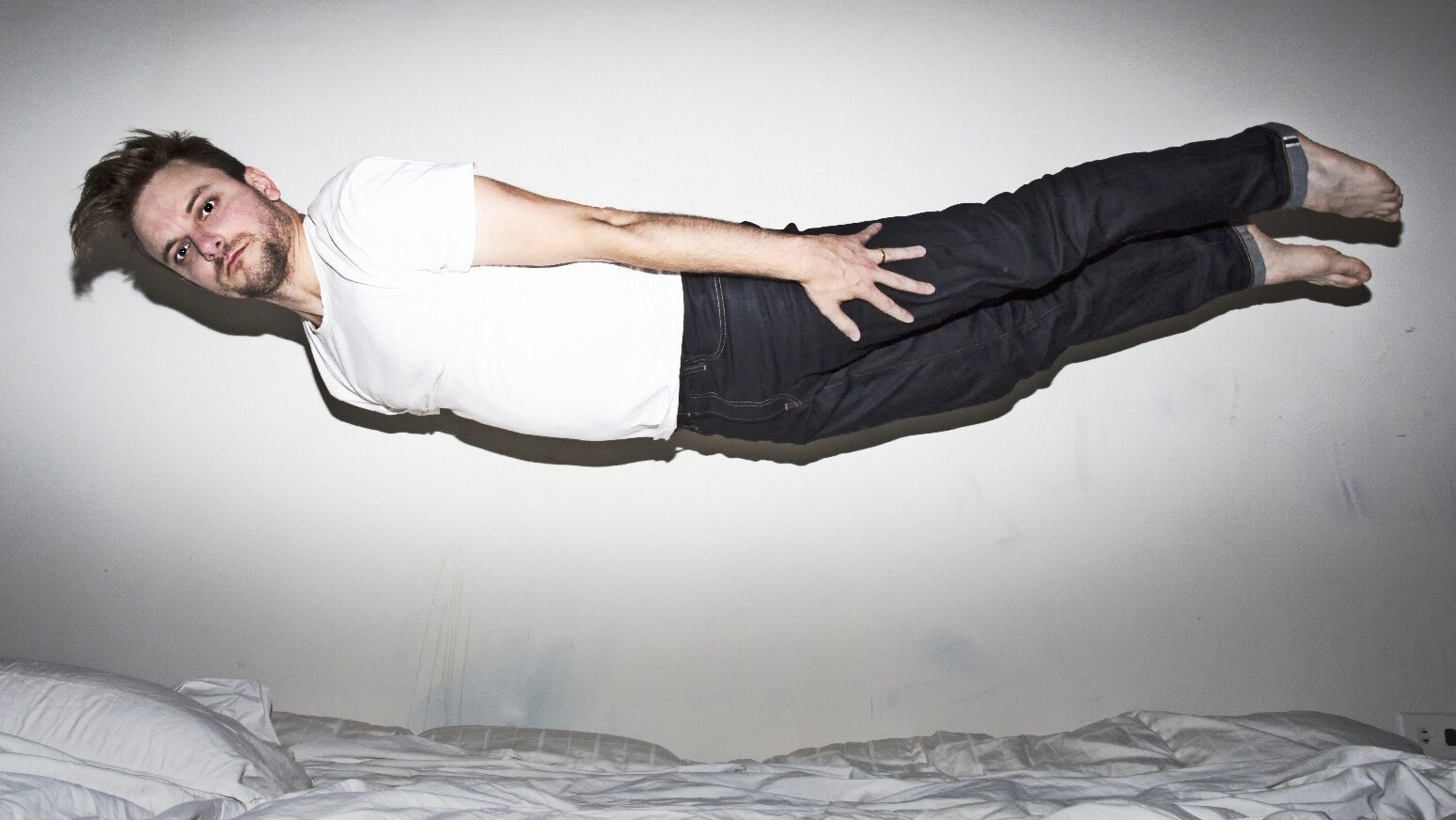About Joanna Kotze
A Brooklyn-based choreographer, dancer, and educator, Joanna Kotze’s work—characterized by a collaborative, multidisciplinary approach—presents ways to experience effort, labor, humor, violence, unpredictability, and beauty through movement as well as the body’s relationship to sound, light, and architecture. During her residency, Kotze and her collaborators will investigate the phenomenon of history repeating itself through a two-part, unison, non-unison, non-hierarchical, canon dance. This new evening-length piece is a collaboration with an intergenerational cast of dancers and musicians contextualizing and reflecting on personal, artistic, and historical patterns and how context and time moving forward can inherently create change. Leading up to her residency, we asked Joanna about her current inspirations, pieces of wisdom, and unique challenges for the upcoming work.

What’s inspiring you right now?
I am intrigued by the phenomenon of history repeating itself – globally, politically, socially, artistically, and personally – and how learning from historic patterns can help to create change. The cycles from history that are repeating right now before are eyes are playing out in ways that demand re-envisioning, resistance, and civic engagement. How does this reflect in the body? What physical and emotional patterns and cycles emerge? How can we propose a robust physicality – in real time – to a live audience?
What can audiences expect from your time in the Pillow Lab?
I will be working with a group of five incredible dancers (Lena Engelstein, Wendell Gray II, Molly Heller, Symara Sarai, and Hsiao-Jou Tang), two amazing musicians (Ryan Seaton and Jennae Santos), and a fantastic writer-in-residence (Lauren Slone) on a two-part, evening length dance and music collaboration. We are not at the beginning of our research – I’d say we are nearing the middle – so it will be a time of experimentation, doing, making, throwing away, generating more material, questioning, watching, and processing. We will be learning and creating physical dance material, building on existing and creating new music material, and developing how the performance space will be arranged. I hope to show both parts in progress so we can start to see their relationship to each other and to the audience.
Is there a piece of advice or wisdom that has stuck with you as an artist?
There are many but here are a few…
My architecture professors: Not everything has to be easy. It doesn’t always need to be a square box.
Risa Steinberg: Always be aware of your back space.
Wally Cardona: The practice is the performance, the performance is the practice.
Jeanine Durning: Start before you’re ready.
Gus Solomons Jr.: You can constantly reinvent yourself as you age
For this dance/project I am interested in how rigorously looking at my own personal and artistic material and patterns – not only historical ones – can inform my current creative process and artistic perspective.
What’s one challenge you’re excited to tackle in your current project?
I don’t usually return to or repeat movement from my past work or processes when I’m making a new dance. I usually move forward: with new material, movement, and choreography. But for this dance/project I am interested in how rigorously looking at my own personal and artistic material and patterns – not only historical ones – can inform my current creative process and artistic perspective.
Another challenge I’m excited to face involves the structure of this new dance. I have never made a two-part piece and I am curious how that bifurcation might lead the research. The structure of the dance will likely morph and change over time, but I am working on it in two sections and I’m excited to see how these investigations inform the project as a whole.
Lastly, with my last two projects, BIG BEATS and ‘lectric Eye, I worked with local professional and advanced student dancers who became a part of the work and performed as their own group in BIG BEATS, and with the core cast in ‘lectric Eye. I loved digging deep with a smaller group of people in order to connect to and learn from a larger community! I am excited to continue this kind of engagement as I develop this new piece.
How has your cultural background or heritage influenced your work?
I was born in South Africa into a politically active family and moved to the States when I was young. Being a young immigrant kept me curious about current events, questioning US politics and its colonialist engagement around the world, and gave me an understanding about how it feels to be treated like an outsider. Dance, and being an artist in general, was and is my way to process these emotions and questions. My work often reflects spectrums – like order to chaos, humor to violence, and intimacy to isolation – that I feel constantly surround us. Making work is my way of physicalizing what the body absorbs on a daily basis.
What’s one thing you always have with you in the studio?
Kneepads! I love doing floor work but I have very boney knees so I always have my kneepads nearby. I get them from Contact Quarterly and they usually feel like they are a part of my body.
Can you describe your artistic journey in three words?
Learning, moving, doing.

Is there something you’re currently reading, watching, or listening to that’s influencing your work?
I am reading several different books on historical cycles, one being Cultural Cycles: Examining the History of the United States – Why It Repeats Itself, and the Next Looming Reset, by J. Eric Wilson.
I’ve also been reading historical novels, biographies, or articles about under-recognized femme lives/stories – Belle de Costa Greene, Elaine Brown, Isabella Stewart Gardner and others.
I’ve been savoring the new collection edited by Thomas F. DeFrantz and Annie-B Parson called Dance History(s): Imagination as a Form of Study, a collection of short books by mayfield brooks, Thomas F. DeFrantz, Keith Hennessy, Bebe Miller, maura nguyen donohue, Okwui Okpokwasili, Eiko Otake, Annie-B Parson, Javier Stell-Frésquez, Ogemdi Ude, Mariana Valencia, and Andrés Zins-Brown and which, to me, speaks to their own dance histories, connections, and cycles.
I read a lot of news about current social and political events, which especially in this moment are reflecting this theme of history repeating itself in a very negative way. The onslaught of infuriating news right now is devastating. This all filters into my body, which filters into the work.
What do you hope to take away from your time at Jacob’s Pillow?
I am most looking forward to the deep dive that this kind of residency allows – concentrated time with collaborators, outside of our day to day lives, where we can continue to get to know each other personally and artistically, infusing deep personal connections into the work that then reflect outwards. I also hope to understand more clearly how the two parts of the piece, both choreographically and musically, come together to create an in depth experience for the audience.
What’s next for you after your residency at the Pillow Lab?
I am actively seeking support for this project both for the creation phase (we need other residencies!) and commissioning/presenting/touring support (we need a venue for the premiere!). So if anyone out there can support us, we are ready for you…
We will be working in NYC this summer and fall with the goal to premiere the piece in 2026, followed by touring. I have a solo residency at Loghaven in the fall where I will be working remotely at times with the dancers and musicians on this piece and also taking time to archive my last evening-length piece, ‘lectric Eye, that developed, premiered, and toured over six years.
I am currently dancing for Kimberly Bartosik, who will have a premiere this fall at New York Live Arts, and Stacy Spence, who’s latest piece will be touring this year as well. I will also be part of a new staging of Anthony and Cleopatra at the Metropolitan Opera, choreographed by Annie-B Parson, this Spring.
You can find more at joannakotze.com or on Instagram @jrkotze.
My collaborators are also doing lots of other projects, including their own work, so you should follow them too!
@icantfindmollyheller, @thatguywen, @symarasarai, @hsiaojou19, @lenaengelstein, @riiiiiiiiiiiiiiiiine, @gushes__, @ramblinree

Inside the Pillow Lab is an intimate film series that captures works in process and behind-the-scenes moments of what it’s like for artists to live, work, and rehearse together in residencies on the Pillow’s retreat-like campus.

A year-round incubator of new work, the Pillow Lab hosts ten artist residencies this fall, winter, and spring. Learn more about the dance artists who will be joining the Pillow during crucial development, research, and technical stages of choreography-driven projects.